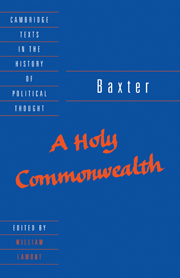Book contents
- Frontmatter
- Contents
- Preface
- Introduction
- Richard Baxter: a chronology
- Further reading
- Biographical notes
- A Holy Commonwealth
- Preface
- An Addition to the Preface
- Adam Contzen the Jesuites Directions
- 1 There is a God that is mans Creator
- 2 God is the Soveraign Ruler of Mankind
- 3 Of the Constitution of Gods Kingdome
- 4 Of the Administration of the Universal Kingdom
- 5 Of a subordinate Commonwealth in General
- 6 Of the several sorts of Commonwealths
- 7 Of the Foundation efficient and conveying causes of Power
- 8 Of the best form of Government, and Happyest Common-wealth
- 9 How a Commonwealth may be reduced to this Theocratical temper, if it have advantages, and the Rulers and People are willing
- 10 Of the Soveraigns Power over the Pastors of the Church, and of the difference of their Offices
- 11 Of the Soveraigns Prerogatives, and Power of Governing by Laws and Judgement
- 12 Of due Obedience to Rulers, and of Resistance
- 13 Of the late Warres Meditations
- Appendix: Preface to The Life of Faith (1670)
- Index
- Title in the Series
Preface
Published online by Cambridge University Press: 05 June 2012
- Frontmatter
- Contents
- Preface
- Introduction
- Richard Baxter: a chronology
- Further reading
- Biographical notes
- A Holy Commonwealth
- Preface
- An Addition to the Preface
- Adam Contzen the Jesuites Directions
- 1 There is a God that is mans Creator
- 2 God is the Soveraign Ruler of Mankind
- 3 Of the Constitution of Gods Kingdome
- 4 Of the Administration of the Universal Kingdom
- 5 Of a subordinate Commonwealth in General
- 6 Of the several sorts of Commonwealths
- 7 Of the Foundation efficient and conveying causes of Power
- 8 Of the best form of Government, and Happyest Common-wealth
- 9 How a Commonwealth may be reduced to this Theocratical temper, if it have advantages, and the Rulers and People are willing
- 10 Of the Soveraigns Power over the Pastors of the Church, and of the difference of their Offices
- 11 Of the Soveraigns Prerogatives, and Power of Governing by Laws and Judgement
- 12 Of due Obedience to Rulers, and of Resistance
- 13 Of the late Warres Meditations
- Appendix: Preface to The Life of Faith (1670)
- Index
- Title in the Series
Summary
In editing this text for the modern reader certain principles were followed. Baxter's ‘Theses’ were retained in their entirety; the additional comments upon each only when they added fresh material. The omissions were indicated in the conventional way. There are arguments for and against retaining the original spelling, but it was decided in this case not to modernise it. Nevertheless there are many obvious original printer's errors which it would have been pedantic to preserve – e.g. ‘everlastiug’ for ‘everlasting’ – and these have been silently corrected, rather than choosing to impose a rather wearying (for the reader) repetition of ‘sic’. Either Baxter, or his printer, got confused with the numbering. There are sometimes, for instance, 1, 2 and 4, and the 3 has been forgotten. Again the decision was taken to correct silently. Italicising in the seventeenth century was not an exact art. The bulk of the text has, therefore, been printed in ordinary roman type, and italicisation has been retained only for genuine emphasis, for foreign words and quotations, and for titles of books. Although many of the original typographical conventions have been preserved, along with the spelling, these have not been observed when they are outside the modern typesetter's apparatus. Where the original printer had used 1, 2, 3 in lists of numbered points, an arabic 1 (instead of a roman numeral) is used to begin the series of numbers.
- Type
- Chapter
- Information
- Baxter: A Holy Commonwealth , pp. vii - viiiPublisher: Cambridge University PressPrint publication year: 1994



